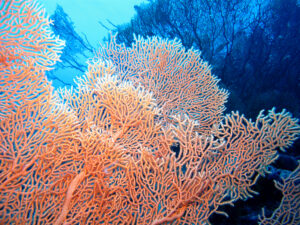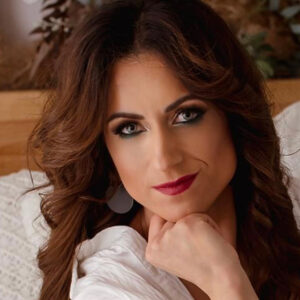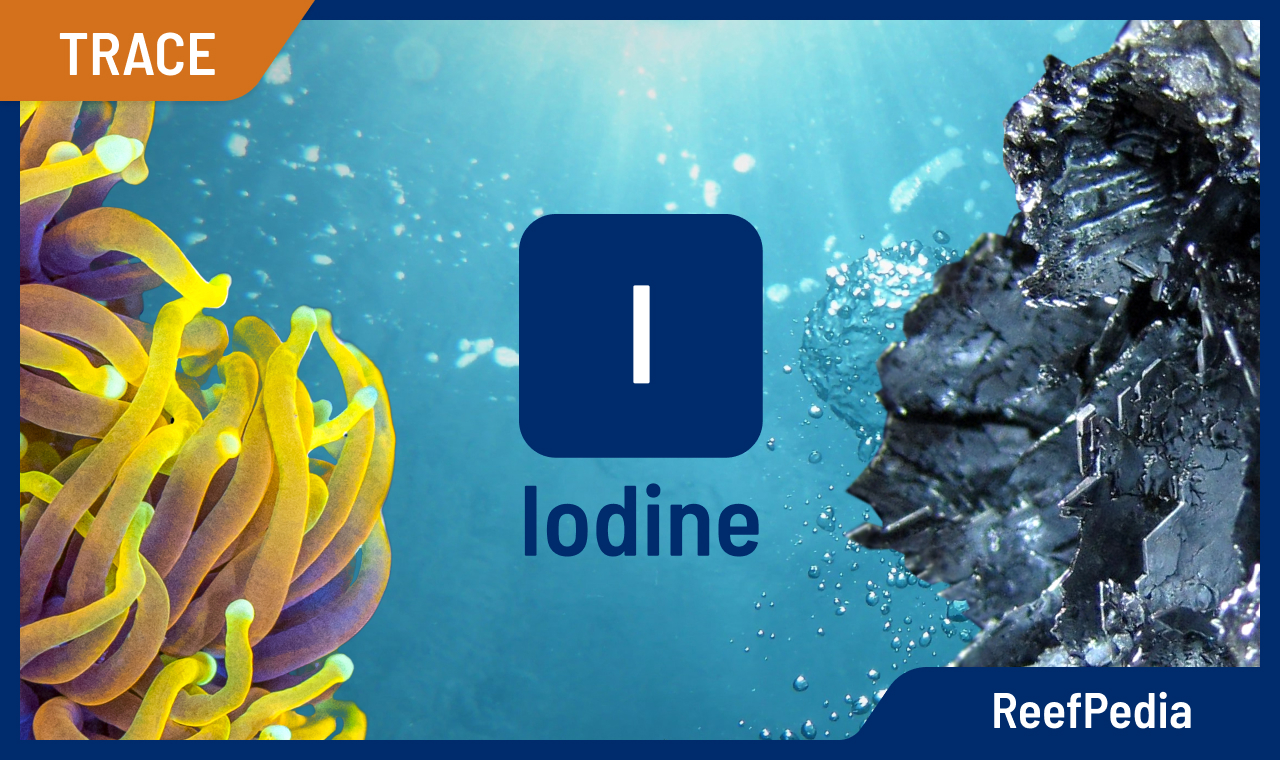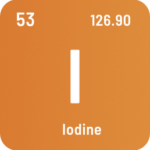 What is IODINE (I)?
What is IODINE (I)?
Iodine (I, Latin iodum) – a chemical element from group 17 of the periodic table of elements, the so-called halogens*. Iodine, like other halogens, is very reactive, especially towards metals with which it reacts to form iodides, e.g. potassium iodide (KI). Iodine occurs in nature in various forms, its organic and inorganic forms are known. The most important inorganic iodine compounds are: potassium iodide (Kl), hydrogen iodide (HI), iodates (IO3–) and periodates (IO4–).
Iodine does not occur in a free form and is one of the elements that is not very common in nature. It constitutes 0.46 ppm of the earth’s crust, taking only 60th place among the elements. In small amounts, it’s commonly found in rocks, soil, seawater and living organisms. Its content in seawater is on average 0.05 ppm (50 μg/L) and depends on its salinity. Marine organisms (e.g. fish, seaweed and corals) are capable of accumulating iodine, reaching concentrations of up to 7% in dry matter (Gorgonia verrucosa coral).

The importance of iodine in seawater
Iodine is one of the most important trace elements in seawater, although its content is relatively low, it is an element necessary for marine animals to live. It can stimulate the growth of algae, tunicates and it’s also used by sponges. Corals, especially many of the soft types, use iodine in their metabolic processes.
Not only is iodine a component of seawater, but some form is present in measurable amounts in virtually every known marine organism.
Iodine is a building block of living organisms, found in bacteria, algae, corals, worms, crustaceans and fish. So, from a biological point of view, we know that iodine is useful.
Three inorganic forms of iodine are the most important in marine aquaristics:
- Iodine – I2
- I– (oxidized form of iodine)
- IO3– (oxidized form of iodine)
Introduced into seawater, iodine undergoes oxidation reactions, which is why in seawater we will mainly find iodates next to iodine and iodides. Iodine oxidation reactions are favored by the environment, seawater (pH>8) and oxygen dissolved in it. UV radiation from the lamps accelerates this process. Corals and biofilms can absorb all of the forms of iodine listed above, so it doesn’t matter what form it comes in.
The basic forms of iodine described above belong to the group of inorganic compounds. Another group is known in chemistry – organic compounds. The main difference between them is that there are carbon atoms in the structure of organic compounds. Both types of chemical compounds, which include iodine, play an important role in biological processes.
Counter-intuitively, the inorganic forms are especially critical because they are the start of a chemical pathway. On the other hand, organic iodine complexes are often by-products of chemical reactions initiated with inorganic substances.
Problems related to excess or deficiency of iodine in seawater
Low iodine concentration causes tarnishing of coral tissues and inhibition of their growth. Corals can become more sensitive to parasites and start shedding zooxanthellae. For other marine organisms, iodine or a lack of it is the cause of deadly diseases. For example, shrimp and some other crustaceans may not be able to go through ecdysis (moulting) – the process by which they shed their old exoskeletons. They may also die while attempting to molt.
Its deficiency causes health problems in fish and some invertebrates. It’s well known that soft corals (especially the pulsating ones), crustaceans and fish suffer from iodine deficiency as well. We also know that macroalgae are a significant absorber of this element. How iodine is absorbed by animals is not strictly defined. Low iodine concentration is manifested by dull tissue, less growth, colorless tops or edges of growth, and sensitivity to bright light.
Too high values lead to darkening of the corals and increased algae growth. A clearly visible symptom of iodine overdose is the increased growth of various algae in the body. The algae take up the iodate and convert it to organic iodine and/or iodide. With high nutrient concentrations and high iodine values, algae growth increases dramatically. Most of them are green-brown to beige in color and grow especially fast on the glass surfaces of the aquarium.
How to protect the aquarium?
Regularly check the iodine content and keep it at the right level. We recommend keeping iodine at a level of 50 – 80 μg/L, the optimal value we recommend is 70 μg/L. Such a level of iodine in seawater ensures health and beautiful coloration of the animals.
Controlling iodine content is not easy. First of all, elemental iodine has the ability to form numerous ionic compounds in seawater. Free iodine (I2) is rarely found in seawater because it quickly transforms into oxidized forms such as iodates.
The most accurate and reliable method of iodine determination is the ICP-OES (Inductively Coupled Plasma Optical Emission Spectrometry) analysis.
Indicators of abnormal iodine level in a marine aquarium
Deficiency:
- Acropora tenuis, a blue or green Montipora species with a blue edge – when complete iodine deficiency begins, the green and blue coloration decreases, growth stops.
- If the total iodine deficiency increases, the coral’s sensitivity to parasites such as AEFW (Acropora Eating Flatworm) increases.
- The aquarium becomes colorless, dull and grayish.
- With extreme iodine deficiency, SPS corals lose their growth tips, there is increased shifting, and RTN-STN infections are more common. With acute iodine deficiency, SPS corals shed tissue from the base.
- Due to fluorine/bromine deficiency, severe iodine deficiency is one of the main causes of dinoflagellate outbreaks, especially in nutrient-deficient conditions. These are often zooxanthellae that have been released by corals under stress.
Excess:
- A clearly visible symptom of an iodine overdose is the increased growth of various algae.
- The algae take up the iodate and convert it to organic iodine and/or iodide.
- The algae growth is mostly green-brown to beige in color and grows particularly fast on the glass surfaces of the aquarium.
Recommendations
To ensure the proper level of iodine in the aquarium, it should be systematically tested.
If the iodine level is above 80 µg/l, we’re dealing with an overdose, especially in SPS corals. Too high levels of this element lead to darkening of the corals and increased algae growth. The most common reasons for exceeding the recommended level of iodine: improperly prepared salt, contaminated supplements, too high doses of supplements administered. Find and eliminate the cause of the problem and lower the value of this parameter in the water. Do up to 6 water changes. It’s recommended that at each water change approximately 15% of the aquarium water volume would be replaced until the recommended value of this parameter is reached. Water prepared for replacement must be characterized by an appropriate level of target salinity. Use salt with the right parameters and composition properly confirmed by the ICP test.
In case of overdose or suspected presence of organic iodine compounds in too high concentration, they can be removed from the water with activated carbon and other absorbers.
As in the case of macroelements, with halogens (compounds of elements of group 17 of the periodic table, such as potassium bromide; KBr) important relationships must be taken into account. An elevated iodine number often occurs simultaneously with a too low fluorine number.
If the level of iodine is below 50 µg/l, we recommend using products containing this element to compensate for it. To ensure a constant level of iodine in a marine aquarium, we recommend systematic supplementation of this element depending on the coral stock.
*The name halogens comes from the name of the first element placed at the top of the seventeenth column of the periodic table (F-fluorine).
About author

Magdalena Metzler
Privately, I am a mother and a lover of nature and sport. My main interest is quantum chemistry, which hides a whole lot of unsolved mysteries and connections, which is extremely exciting from a scientific point of view.
In my scientific career, I have conducted international projects focused on innovative solutions for many branches of business, e.g. automotive, construction, and now, of course, marine aquaristics.
Working at Reef Factory gave me a passion for marine aquaristics, which I can develop every day, building a chemistry department and creating products that will help aquarists take care of tanks and ensure the highest safety of animals.
One of the most exciting memories of working at Reef Factory is the commissioning of the ICP-OES spectrometer, which analyzes the elemental composition of seawater. The method of analysis in ICP is based on an analytical technique, which is a combination of my passion for quantum chemistry and marine aquaristics.
I hope you find my articles on ReefPedia interesting and helpful! Happy reading :))
Magda


 What is IODINE (I)?
What is IODINE (I)?